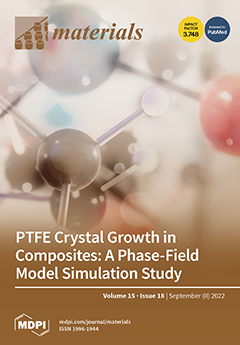For the first time, the possibility of obtaining B-site disordered, Ruddlesden–Popper type, high-entropy oxides has been proven, using as an example the LnSr(Co,Fe,Ga,Mn,Ni)O
4 series (Ln = La, Pr, Nd, Sm, or Gd). The materials were synthesized using the Pechini method, followed by
[...] Read more.
For the first time, the possibility of obtaining B-site disordered, Ruddlesden–Popper type, high-entropy oxides has been proven, using as an example the LnSr(Co,Fe,Ga,Mn,Ni)O
4 series (Ln = La, Pr, Nd, Sm, or Gd). The materials were synthesized using the Pechini method, followed by sintering at a temperature of 1200 °C. The XRD analysis indicated the single-phase,
I4/
mmm structure of the Pr-, Nd-, and Sm-based materials, with a minor content of secondary phase precipitates in La- and Gd-based materials. The SEM + EDX analysis confirms the homogeneity of the studied samples. Based on the oxygen non-stoichiometry measurements, the general formula of LnSr(Co,Fe,Ga,Mn,Ni)O
4+δ, is established, with the content of oxygen interstitials being surprisingly similar across the series. The temperature dependence of the total conductivity is similar for all materials, with the highest conductivity value of 4.28 S/cm being reported for the Sm-based composition. The thermal expansion coefficient is, again, almost identical across the series, with the values varying between 14.6 and 15.2 × 10
−6 K
−1. The temperature stability of the selected materials is verified using the in situ high-temperature XRD. The results indicate a smaller impact of the lanthanide cation type on the properties than has typically been reported for conventional Ruddlesden–Popper type oxides, which may result from the high-entropy arrangement of the B-site cations.
Full article






